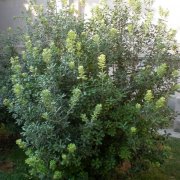Care of the shrub Pittosporum crassifolium or Karo |
|
The genus Pittosporum, family Pittosporaceae, includes 200 species of trees and shrubs native to Oceania, Asia and Africa. Some species are: Pittosporum crassifolium, Pittosporum tenuifolium, Pittosporum truncatum, Pittosporum coriaceum, Pittosporum x pourtetianum, Pittosporum heterophyllum, Pittosporum angustifolium, Pittosporum tobira. Common names: Karo, Stiffleaf cheesewood. This species is native to New Zealand. They are fast-growing evergreen shrubs with a rounded bearing that reach 5 meters (16.4 feet) in height. The leaves are oval and grayish green on the upper side; on the underside they have white hairs. The maroon colored flowers produce more scent at night. They bloom from spring to early summer. Karo is used to form hedges, as isolated specimens and in bushy groups. It's ideal for coastal gardens due to its resistance to wind and salinity. Pittosporum crassifolium grows in full sun and semi-shade exposures. It resists frost down to -7 ºC (19.4 ºF). The soil can be normal, well-drained garden soil with coarse sand and containing organic matter. Cover the base of the plant with pine bark. Water regularly, waiting for the substrate to dry completely; Karo resists drought well. Young plants need more watering until they are established. Fertilize at the end of winter with humus or compost. Prune young plants vigorously in late spring if grown as a hedge. Stiffleaf cheesewood tolerates light pruning in late winter to maintain a compact appearance. Pittosporum crassifolium is a quite resistant plant to the usual pests and diseases that can be attacked by some insects. Stiffleaf cheesewood propagates from seeds sown in spring and by cuttings in summer. |
Images of the shrub Pittosporum crassifolium or Karo |
Find plants
Pittosporum crassifolium or Karo | Care and Growing
© 2025 FavThemes


